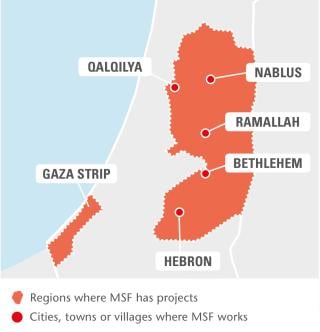
5,100
5,1
400
4
350
35
West Bank
There was an upsurge in violence in the West Bank at the beginning of the year, and although the situation had calmed by the end of March, the H2 area of Hebron city, which is highly militarised, experienced frequent confrontations. MSF’s patients have been exposed to various critical events, such as witnessing violence, raids on their homes, arrests and deaths of family members, and consequently, they have developed anxiety, stress and sleeping problems.
MSF runs mental health programmes in Hebron, Nablus, Qalqilya, Bethlehem and Ramallah governorates offering psychological and social support to victims of political violence. In 2016, 4,141 new patients benefited from individual and group mental health sessions, over 70 per cent of which were in Hebron. The team marked 20 years of working in Hebron with a series of public events to highlight the importance of mental health services in Palestine, including multimedia activities, plays and presentations of personal stories by patients.
In addition to medical care, the team provided training for medical staff, teachers and counsellors. In April, MSF opened an innovative emergency response project covering Bethlehem and Ramallah governorates, focusing on offering psychological first aid and psychoeducational support.
In 2016, MSF started a partnership with An-Najah University in Nablus to launch the first Master’s degree in clinical psychology in Palestine. MSF staff also supported the burns unit of Rafidya hospital in Nablus, where they focused on moderate to severe cases through a multidisciplinary approach (psychological, medical and social).

Gaza Strip
MSF´s burns and trauma centres in the Gaza Strip treated over 4,231 patients, mostly children. Staff dressed more than 52,000 wounds, and conducted over 36,000 physiotherapy and 1,000 occupational therapy sessions. The majority of patients had burns, usually the result of domestic accidents in conflict-damaged homes. There are three centres, in Gaza City, Khan Younis and Bet Lahyia, the last of which opened in July this year. In 2016, MSF’s burns awareness campaign reached more than 35,500 children in schools, kindergartens and nurseries.
The surgical programmes that MSF runs in Al Shifa and Nasser hospitals in conjunction with the health ministry performed a total of 275 surgical interventions, 71 per cent of them on children under 16 years of age.
Complex cases that cannot be handled in Gaza are referred to MSF’s reconstructive surgery hospital in Jordan. However, due to administrative delays, only nine out of 77 patients were successfully referred in 2016.

















